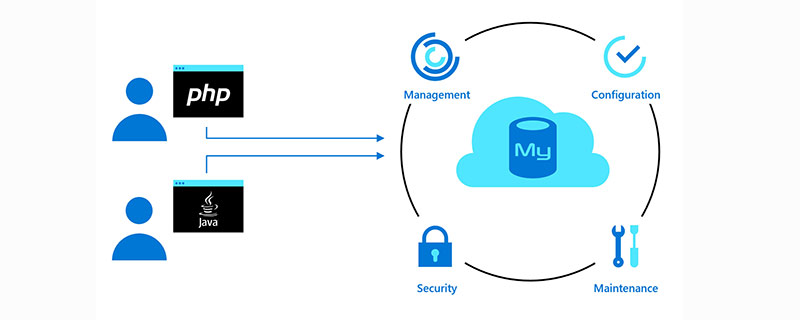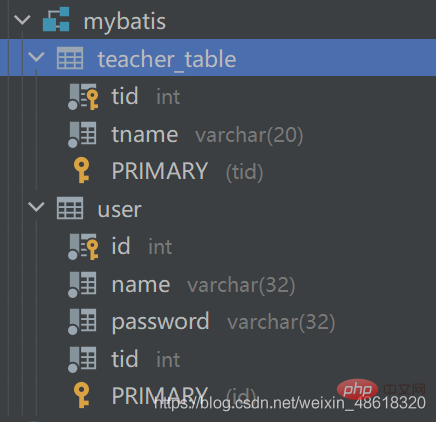Understand the basics of Mybatis

Free learning recommendation: mysql video tutorial
##mybatis
mybatis-config.xml detailed configuration (when configuring, you must delete the redundant attributes and cannot have Chinese characters, otherwise an error will be reported!)<?xml version="1.0" encoding="UTF-8" ?>nbsp;configuration
PUBLIC "-//mybatis.org//DTD Config 3.0//EN"
"http://mybatis.org/dtd/mybatis-3-config.dtd"><!--configuration核心配置 配置文件的根元素 --><configuration>
<!-- 属性:定义配置外在化 -->
<properties></properties>
<!-- 设置:定义mybatis的一些全局性设置 -->
<settings>
<!-- 具体的参数名和参数值 -->
<setting></setting>
</settings>
<!-- 类型名称:为一些类定义别名 -->
<typealiases>
<!-- 实体类少 建议 第一种取别名方式-->
<typealias></typealias>
<!--实体类多 建议 第二种取别名方式
默认情况下用这种方式 别名为类名 首字母最好小写
-->
<package></package>
</typealiases>
<!-- 类型处理器:定义Java类型与数据库中的数据类型之间的转换关系 -->
<typehandlers></typehandlers>
<!-- 对象工厂 -->
<objectfactory></objectfactory>
<!-- 插件:mybatis的插件,插件可以修改mybatis的内部运行规则 -->
<plugins>
<plugin></plugin>
</plugins>
<!-- 环境:配置mybatis的环境 -->
<environments>
<!-- 环境变量:可以配置多个环境变量,比如使用多数据源时,就需要配置多个环境变量 -->
<environment>
<!-- 事务管理器 -->
<transactionmanager></transactionmanager>
<!-- 数据源 配置连接我的数据库-->
<datasource>
<property></property>
<property></property>
<property></property>
<property></property>
</datasource>
</environment>
</environments>
<!-- 数据库厂商标识 -->
<databaseidprovider></databaseidprovider>
<!-- 映射器:指定映射文件或者映射类 -->
<mappers>
<mapper></mapper>
</mappers></configuration>Paging
Reduce the amount of data access limt implements paging
sql statement: select * from table name limt 0,5;
- 0: The starting position of the data
- 5: Data length
The first type: using Mybatis 1 interface
List<user> getUserByLimit(Map<string> map);</string></user>
<select>
select *
from mybatis.user
limit ${starIndex},${pageSize} </select><resultmap> <result></result> </resultmap>
@Test
public void getUserByLimitTest() {
SqlSession sqlSession = MyBatisUtils.getSqlSession ();
UserMapper mapper = sqlSession.getMapper (UserMapper.class);
HashMap hashMap = new HashMap<string> ();
hashMap.put ("starIndex", 1);
hashMap.put ("pageSize", 2);
List userByLimit = mapper.getUserByLimit (hashMap);
for (Object o : userByLimit) {
System.out.println (o);
}
sqlSession.close ();
}</string>Second: Use RowBounds method 1. Interface
List getUserList();
2. Implement the interface
<select> select * from mybatis.user </select>
/**
* 测试使用RowBounds实现分页
*/@Test
public void getUserByLimitRowBoundsTest() {
SqlSession sqlSession = MyBatisUtils.getSqlSession ();
RowBounds rowBounds = new RowBounds (0, 2);
List<user> userList = sqlSession.selectList ("com.kuang.w.dao.UserMapper.getUserList", null, rowBounds);
for (User user : userList) {
System.out.println (user);
}
//关闭
sqlSession.close ();
}</user>Third method: Use Mybatis’ paging plug-in pageHeIper
sql Many-to-one processing
Database:
pojo The teacher-table table in the database corresponds to the entity class Teacher
package com.kuang.w.pojo;
import lombok.Data;
/**
* @author W
*/
@Data
public class Teacher {
private int tId;
private String tName;
}package com.kuang.w.pojo;import lombok.Data;/**
* @author W
*/@Datapublic class Student {
private int id;
private int tid;
private String name;
private String password;
private Teacher teacher;}List<student> getStudentList();</student>
<!-- 多对一查询
1 子查询 mysql 通过一个表里是数据 与另一个表的一个数据相的情况下 查询另一个的数据 一起显示
-->
<select>
select *
from mybatis.user; </select>
<resultmap>
<!-- 复杂属性 对象用 :association 集合用:collection-->
<!--column 数据库中的字段 property 实体类中的属性-->
<result></result>
<result></result>
<result></result>
<!--javaType 一个 Java 类的全限定名
,或一个类型别名(关于内置的类型别名,可以参考上面的表格)。
如果你映射到一个 JavaBean,MyBatis 通常可以推断类型。
然而,如果你映射到的是 HashMap,
那么你应该明确地指定 javaType 来保证行为与期望的相一致。-->
<association></association>
</resultmap>
<select>
select *
from mybatis.teacher_table
where tid = #{id}; </select><!--2 多表联查--> <select> select u.id uid, u.name uname, u.password upassword, u.tid utid, t.tname from mybatis.user u, mybatis.teacher_table t where t.tid = u.tid; </select> <!-- 映射--> <resultmap> <result></result> <result></result> <result></result> <result></result> <association> <result></result> </association> </resultmap>
<?xml version="1.0" encoding="UTF8" ?>nbsp;configuration
PUBLIC "-//mybatis.org//DTD Config 3.0//EN"
"http://mybatis.org/dtd/mybatis-3-config.dtd"><configuration>
<properties></properties>
<settings>
<setting></setting>
</settings>
<typealiases>
<typealias></typealias>
<typealias></typealias>
</typealiases>
<environments>
<environment>
<transactionmanager></transactionmanager>
<datasource>
<property></property>
<property></property>
<property></property>
<property></property>
</datasource>
</environment>
</environments>
<mappers>
<!-- <mapper resource="com/kuang/w/dao/TeacherMapper.xml"></mapper>
<mapper resource="com/kuang/w/dao/StudentMapper.xml"></mapper>-->
<mapper></mapper>
<mapper></mapper>
</mappers></configuration> @Test
public void getStudentListTest() {
SqlSession sqlSession = MyBatisUtils.getSqlSession ();
StudentMapper mapper = sqlSession.getMapper (StudentMapper.class);
List<student> studentList = mapper.getStudentList ();
for (Student student : studentList) {
System.out.println (student);
}
sqlSession.commit ();
sqlSession.close ();
}</student>sql one-to-many processing
The entity class corresponding to the data table structure remains unchanged
First way: Multi-table joint query 1 interface
List<teacher> getTeacher(int tid);</teacher>
<select>
select t.tid, t.tname, u.id, u.name, u.password
from mybatis.user u,
mybatis.teacher_table t
where t.tid = u.tid
and t.tid = #{tid}; </select><resultmap> <result></result> <result></result> <!-- 复杂属性 对象用 :association 集合用:collection--> <collection> <!--javaType 指定属性类型 一个 Java 类的全限定名--> <result></result> <result></result> <result></result> <result></result> </collection> </resultmap>
/*测试一对多*/
@Test
public void getTeacherTest2() {
SqlSession sqlSession = MyBatisUtils.getSqlSession ();
TeacherMapper mapper = sqlSession.getMapper (TeacherMapper.class);
List<teacher> teacher = mapper.getTeacher (1);
for (Teacher teacher1 : teacher) {
System.out.println (teacher1);
}
//提交事务 架子 这里可以不要
sqlSession.commit ();
// 关闭
sqlSession.close ();
}</teacher>com.intellij.rt.junit.JUnitStarter -ideVersion5 -junit4 com.kuang.w.dao.myTest,getTeacherTest2 Logging initialized using 'class org.apache.ibatis.logging.stdout.StdOutImpl' adapter.PooledDataSource forcefully closed/removed all connections.PooledDataSource forcefully closed/removed all connections.PooledDataSource forcefully closed/removed all connections.PooledDataSource forcefully closed/removed all connections.Opening JDBC Connection Created connection 164974746.Setting autocommit to false on JDBC Connection [com.mysql.cj.jdbc.ConnectionImpl@9d5509a]==> Preparing: select t.tid, t.tname, u.id, u.name, u.password from mybatis.user u, mybatis.teacher_table t where t.tid = u.tid and t.tid = ?; ==> Parameters: 1(Integer)Second way: Subquery1Interface
2 Implement interfaceList<teacher> getTeacher(int tid);</teacher>Copy after login3Test the same as above<!--第二种方式: 子查询--> <select> select * from mybatis.teacher_table where tid = #{tid}; </select> <resultmap> <!-- 复杂属性 对象用 :association 集合用:collection 我们需要单独处理对象: association 集合: collection javaType=""指定属性的类型! 集合中的泛型信息,我们使用ofType 获取 --> <result></result> <result></result> <collection> </collection> </resultmap> <select> select * from mybatis.user where tid = #{tid}; </select>Copy after login. . . .
Related free learning recommendations: mysql database(Video)
The above is the detailed content of Understand the basics of Mybatis. For more information, please follow other related articles on the PHP Chinese website!

Hot AI Tools

Undresser.AI Undress
AI-powered app for creating realistic nude photos

AI Clothes Remover
Online AI tool for removing clothes from photos.

Undress AI Tool
Undress images for free

Clothoff.io
AI clothes remover

Video Face Swap
Swap faces in any video effortlessly with our completely free AI face swap tool!

Hot Article

Hot Tools

Notepad++7.3.1
Easy-to-use and free code editor

SublimeText3 Chinese version
Chinese version, very easy to use

Zend Studio 13.0.1
Powerful PHP integrated development environment

Dreamweaver CS6
Visual web development tools

SublimeText3 Mac version
God-level code editing software (SublimeText3)

Hot Topics
 1389
1389
 52
52
 When might a full table scan be faster than using an index in MySQL?
Apr 09, 2025 am 12:05 AM
When might a full table scan be faster than using an index in MySQL?
Apr 09, 2025 am 12:05 AM
Full table scanning may be faster in MySQL than using indexes. Specific cases include: 1) the data volume is small; 2) when the query returns a large amount of data; 3) when the index column is not highly selective; 4) when the complex query. By analyzing query plans, optimizing indexes, avoiding over-index and regularly maintaining tables, you can make the best choices in practical applications.
 Explain InnoDB Full-Text Search capabilities.
Apr 02, 2025 pm 06:09 PM
Explain InnoDB Full-Text Search capabilities.
Apr 02, 2025 pm 06:09 PM
InnoDB's full-text search capabilities are very powerful, which can significantly improve database query efficiency and ability to process large amounts of text data. 1) InnoDB implements full-text search through inverted indexing, supporting basic and advanced search queries. 2) Use MATCH and AGAINST keywords to search, support Boolean mode and phrase search. 3) Optimization methods include using word segmentation technology, periodic rebuilding of indexes and adjusting cache size to improve performance and accuracy.
 Can I install mysql on Windows 7
Apr 08, 2025 pm 03:21 PM
Can I install mysql on Windows 7
Apr 08, 2025 pm 03:21 PM
Yes, MySQL can be installed on Windows 7, and although Microsoft has stopped supporting Windows 7, MySQL is still compatible with it. However, the following points should be noted during the installation process: Download the MySQL installer for Windows. Select the appropriate version of MySQL (community or enterprise). Select the appropriate installation directory and character set during the installation process. Set the root user password and keep it properly. Connect to the database for testing. Note the compatibility and security issues on Windows 7, and it is recommended to upgrade to a supported operating system.
 Difference between clustered index and non-clustered index (secondary index) in InnoDB.
Apr 02, 2025 pm 06:25 PM
Difference between clustered index and non-clustered index (secondary index) in InnoDB.
Apr 02, 2025 pm 06:25 PM
The difference between clustered index and non-clustered index is: 1. Clustered index stores data rows in the index structure, which is suitable for querying by primary key and range. 2. The non-clustered index stores index key values and pointers to data rows, and is suitable for non-primary key column queries.
 MySQL: Simple Concepts for Easy Learning
Apr 10, 2025 am 09:29 AM
MySQL: Simple Concepts for Easy Learning
Apr 10, 2025 am 09:29 AM
MySQL is an open source relational database management system. 1) Create database and tables: Use the CREATEDATABASE and CREATETABLE commands. 2) Basic operations: INSERT, UPDATE, DELETE and SELECT. 3) Advanced operations: JOIN, subquery and transaction processing. 4) Debugging skills: Check syntax, data type and permissions. 5) Optimization suggestions: Use indexes, avoid SELECT* and use transactions.
 The relationship between mysql user and database
Apr 08, 2025 pm 07:15 PM
The relationship between mysql user and database
Apr 08, 2025 pm 07:15 PM
In MySQL database, the relationship between the user and the database is defined by permissions and tables. The user has a username and password to access the database. Permissions are granted through the GRANT command, while the table is created by the CREATE TABLE command. To establish a relationship between a user and a database, you need to create a database, create a user, and then grant permissions.
 Explain different types of MySQL indexes (B-Tree, Hash, Full-text, Spatial).
Apr 02, 2025 pm 07:05 PM
Explain different types of MySQL indexes (B-Tree, Hash, Full-text, Spatial).
Apr 02, 2025 pm 07:05 PM
MySQL supports four index types: B-Tree, Hash, Full-text, and Spatial. 1.B-Tree index is suitable for equal value search, range query and sorting. 2. Hash index is suitable for equal value searches, but does not support range query and sorting. 3. Full-text index is used for full-text search and is suitable for processing large amounts of text data. 4. Spatial index is used for geospatial data query and is suitable for GIS applications.
 Can mysql and mariadb coexist
Apr 08, 2025 pm 02:27 PM
Can mysql and mariadb coexist
Apr 08, 2025 pm 02:27 PM
MySQL and MariaDB can coexist, but need to be configured with caution. The key is to allocate different port numbers and data directories to each database, and adjust parameters such as memory allocation and cache size. Connection pooling, application configuration, and version differences also need to be considered and need to be carefully tested and planned to avoid pitfalls. Running two databases simultaneously can cause performance problems in situations where resources are limited.




